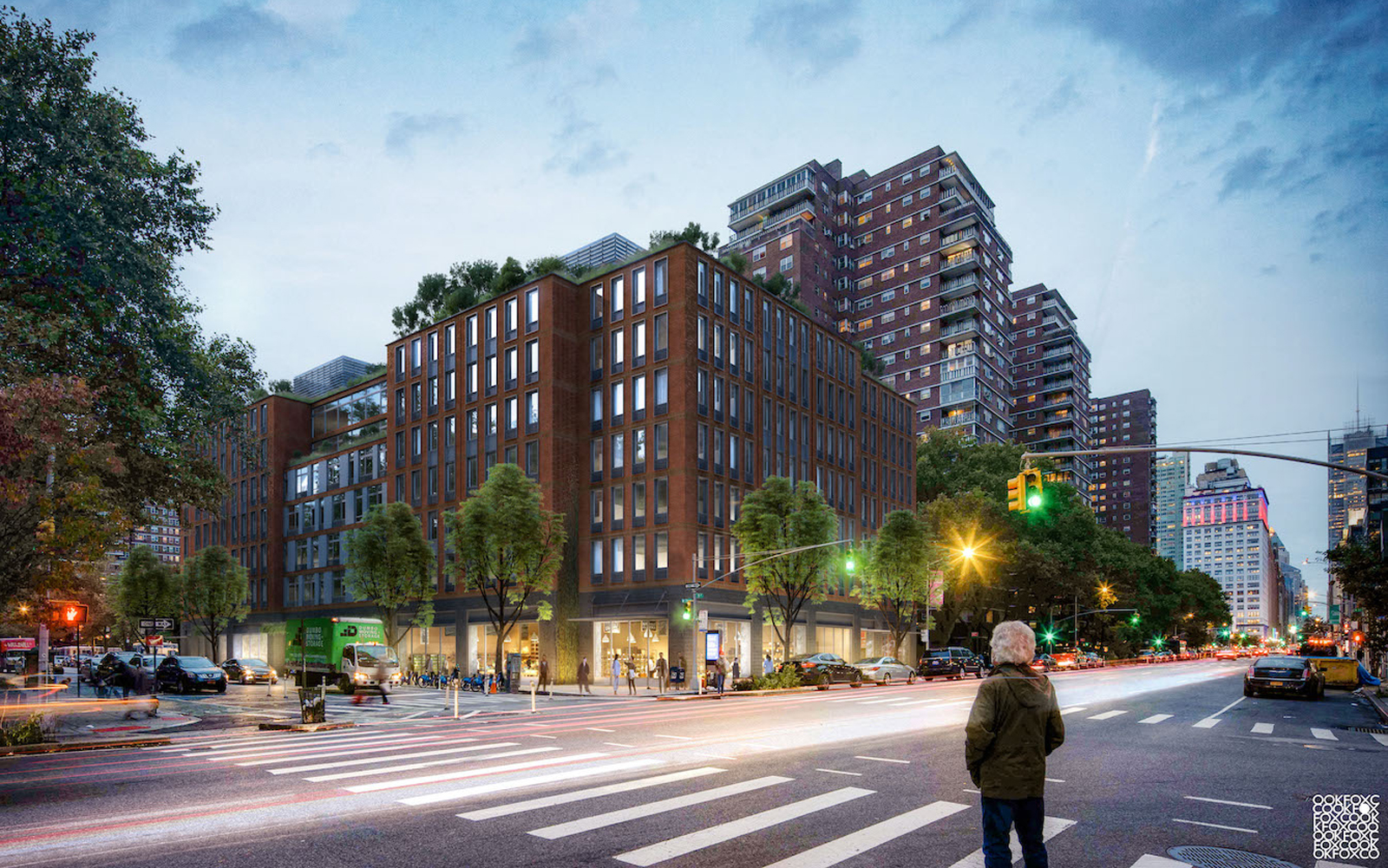On a balcony in Chelsea, with views that sweep the West Side of Manhattan, MaryAnne Gilmartin is looking at the scene below, taking in the progress of her company’s newest development.
It is the kind of project that gives Gilmartin a good feeling, built on West 26th Street on land owned by the Penn South co-op village.
“It resembles the New York I grew up with and love,” says Gilmartin, now 60. She mentions a Lidl grocery store coming to the property, in contrast with what she calls the “towers of power” at nearby Hudson Yards.
“They look like something out of Shanghai,” she says, and casually adds that Related Companies, a major developer at Hudson Yards, was a competing bidder for the co-op’s ground lease.
With that project and another in Midtown East topping out, Gilmartin is closing in on a 900-unit portfolio of new multifamily apartments since launching her company, MAG Partners, in 2018.
“MaryAnne’s goal in life is building,” said Mary Ann Tighe, the legendary CBRE broker who Gilmartin credits as her longtime mentor.
The company is a year into leasing its largest project, a 480-unit through-block property on West 28th Street, also built by virtue of a ground lease, this time from the Gottesman family of the Edison parking empire.
MAG brought equity partners into its two latest projects — Eyal Ofer’s Global Holdings on East 50th Street and MetLife Investment Management at the Penn South co-op — amid tighter financial conditions and New York’s uncertain regulatory environment.
On West 28th Street, construction debt from Madison Realty Capital was refinanced by Elliot Investment Management in a joint venture with Adi Chugh.
“MaryAnne’s goal in life is building.”
To Gilmartin, it felt as though the projects were among the last in the city to get financing to qualify for the then-expiring 421a tax abatement — which has since been extended, and will be replaced by a new provision dubbed 485x.
“For a company like us, we might be interested in building projects with under 100 units,” Gilmartin said. Such projects would prevent wage requirements from kicking in under 485x as well as reduce the affordability requirement from 25 to 20 percent of new apartments.
From the balcony where Gilmartin stands, past achievements dot the skyline, including the New York Times building and the Frank Gehry-designed 8 Spruce Street. Prodded about these accomplishments, which Gilmartin tackled while at Forest City Ratner, she explains them in ways that bolster her image as a developer who can overcome any obstacle.
Skyscrapers were anathema following 9/11, yet the Times building, designed by Renzo Piano, began to rise in 2004; the Gehry tower was realized despite the Great Financial Crisis threatening to topple a $680 million loan syndicate, according to Gilmartin. She bills her current projects as a triumph over Covid and unpredictable public policy.
Once one of the city’s most ambitious developers, Forest City vaulted Gilmartin’s career before its Atlantic Yards project scarred her personally — and maybe professionally.
Luckily for Gilmartin, she seems to relish doing the difficult.
Charm City
Today, Gilmartin’s biggest undertaking sits on a forgotten industrial peninsula in south Baltimore, a vastly different place than the one where she honed her reputation as a steadfast New York developer.
“When it first came up, I’m like, Baltimore, really?” said Andrew Trickett, formerly of Safanad, which provided equity backing to MAG’s multifamily projects in Manhattan, thanks in part to an introduction from Safanad board member and top New York real estate attorney Marty Edelman.
Gilmartin’s change of scenery began about two years ago, and although she emphasizes that she works simultaneously in New York and Baltimore, that change also reflects the city that made her.

“In Baltimore, they actually welcome you,” she says, echoing a common refrain among New York developers who have pursued projects in other cities.
Gilmartin frequently blasts New York City politics on her active public speaking schedule, where she charms audiences with industry anecdotes and advocates for more women to join her field.
“The only reason Eric Adams needs to call his housing plan ‘the City of Yes’ is that everyone knows that New York is the ‘city of no’ and has been that way for a long time,” she says matter-of-factly.
Baltimore was once dubbed “America’s Comeback City,” and Gilmartin’s company of 30 employees will try to create a new comeback story there by developing 1.1 million square feet of new residential, office and hospitality properties on a 235-acre spread owned by Under Armour CEO Kevin Plank. It is a $5.5 billion development, backed by Goldman Sachs.
“Plank says he hired a New York street fighter to help him in Baltimore,” says Gilmartin.
That kind of reception is a welcome change to Gilmartin, against whom recriminations over Atlantic Yards became deeply personal. Twenty years ago, the hugely ambitious redevelopment of Brooklyn’s Prospect Heights brought protesters to her family home in Park Slope when local residents were displaced. As Forest City wound down its New York operations, Gilmartin cut the deal to sell the project to Greenland, a Chinese firm that has since defaulted on its debt.
Before Safanad agreed to partner with MAG on its three New York projects, Trickett conducted due diligence that included understanding Gilmartin’s role in Atlantic Yards. “I think it was painful for her,” he said. “In everything that we could uncover, she was as above board as you can be in a difficult situation.”
According to Trickett, “I don’t think Baltimore was a reach out because New York was too hard. It was really relationship-based,” he said, referring to Plank and Goldman, among others. “There may be a ton that can come out of this.”
Scrapes and a scrapbook
A Queens native, Gilmartin emerged from real estate obscurity.
After her father walked out on the family with the babysitter, she and two sisters grew up with their mother in Woodstock, where a stepfather appeared and landed in jail for tax evasion. Her determination to escape the chaos of her family life often translated to real estate ambition.
“We were both self-inventions,” said Tighe. “We had huge ambitions for what we wanted to be.” Gilmartin regularly says she “won the career lottery” by meeting Tighe, and she has tried to emulate that relationship.
“Plank says he hired a New York street fighter to help him in Baltimore.”
“MaryAnne was a tremendous mentor to me,” said Susi Yu, the former head of development at MAG. “She put me in front of Bruce [Ratner]. She showed me what it was to work professionally at a high level and still show up as a mother.”
Gilmartin hired Yu out of Columbia University’s graduate real estate program to work at Forest City, eventually taking Yu with her to start MAG. “Don’t get me wrong,” Yu added. “She’s tough as a boss.”
Yu left MAG a year ago to pursue building film and TV studios in New York alongside Travis Feehan and Bain Capital. During her last year at the development firm, there were internal discussions aimed at finding a financial backer for a new round of projects.
That financial backer has yet to emerge. Still, Gilmartin is sure she doesn’t want to go piecemeal, and says she needs a partner that can guarantee the completion, speaking financially, of more than a single development project at a time.
Ideally for her, that person is a woman.
One of Gilmartin’s longstanding goals is to complete a development project with a woman in each of its leadership roles. To date, a female financial partner has eluded her most (and an investment banker who happens to be a woman isn’t going to cut it, she says). Gilmartin’s own ambitions may also complicate the picture.
“I think Safanad has been a perfect partner,” said Trickett, now at Lendlease. “It just may not be at the necessary scale for what she is trying to do over the next five, 10, 15 years.”

To match money supply with money demand, Gilmartin convenes a weekly “hunting group” to prospect for deals. Pursuits include ground leases for residential and mixed-use, public-private partnerships and sports-anchored master plans. While enthusiastic about office-to-residential conversions, “it may be too early on those to lower the cost basis,” she says.
In the meantime, there are some loose ends to tie up.
In a crawling Uber ride through Midtown, Gilmartin is on her way to a meeting about rolling over debt on her 480-unit rental building in Chelsea. Her hope is to avoid putting permanent debt on the project, given the current level of interest rates. If accomplished, she can add it to a long list of her publicized achievements over the years.
As the car turns into a tunnel, with the gilded clock on Grand Central’s facade just visible and Gilmartin’s face darkened, impossible to decipher, she briefly revisits her turbulent upbringing. Did her parents’ deaths cut short hopes of a reconciliation, or of finally receiving their affirmation? She reveals a secret her mother kept.
“After she died, I went with my sisters and we found a scrapbook,” she says, opening an imaginary book with her hands. “She had kept everything we’d done, cut out from newspapers and pasted inside.”
“My sister joked that my section seemed to be the thickest.”

